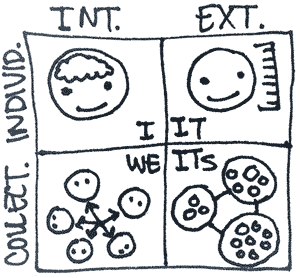 |

|
 |
 |
 |
 |
| title |
|
|
|
|
|
| Four
Quadrant Model |
| industry/topic |
description |
group
size |
image
size |
time |
date |
| integral
theory |
real-time
journaling |
na |
8"x8" |
na |
03.06 |
|
The
Really, Really Big Picture
Cliche aside, I have always been a Big Picture thinker. I'm
the one in the group finding the connections, overlaps, trying
to put all the pieces together.
I'm the luckiest gal in the world, because my work as a graphic
facilitator allows me to use my thinking and drawing
skills to draw the Big Picture for groups of people. I love
that when I'm drawing at a big piece of paper in front of
a group of people, that I am building their Big Picture for
them. I help them see the whole of their problem (it's complexity
and patterns) so they can solve it.
I love that my work introduces me to all sorts of tools and
methodologies that smart folks have developed with that shared
goal of helping people understand each other and solve problems.
Recently, my colleague Sari
Gluckin introduced me to Integral
Theory. She was excited to learn about a four quadrant
model that would enrich her facilitation work. She pointed
me to the Integral
Institute website and after three pages on the
Integral
Approach and I was smitten with the ideas.
Okay, I'm very new to integral theory myself. I'm also very
excited about it. So, I hope my enthusiasm compensates for
any inaccuracies. There's this really, really smart fella
named Ken
Wilber. He reads about a bajillion things and reads
them not to figure out who's right and who's wrong, but how
all these pieces of human consciousness and knowledge fit
into a whole. Wilber is working towards a Theory
of Everything. I'm impressed with Wilber's vast
amounts of scholarship and of production and that within those
two disciplines he's always crediting every idea's source
and invites people to challenge his proposals. He wants that
Theory of Everything to be as comprehensive as possible.
Okay, okay. So, what I'm really geeked out about is Wilber's
Four Quandrant model in his book The
Theory of Everything. Here's
the text version from the source, which is too
well explained to compete with. Here's the essence of the
model:
| |
internal
|
external
|
|
individual
|
I
|
IT
|
| collective |
WE
|
ITS
|
See? Brilliant, eh? It holds everything. Yeah, it makes perfect
sense to me, because I think in models and images like this.
If you're scratching your head, try
this page.
This weekend I partook in I-WET. The acronym makes me feel
like I'm doing something dirty, but it stands for Integral
Weekend Experiential Training. I'll confess - the
weekend felt too Upper Left quandrant for my theory-adoring
self. I drew the four quadrants for myself:

I admit it's kinda gilding the lily, but I think the images
support those tiny but vast words I, IT, WE, ITS.
Here's a quick, scribbled on a napkin version I use when I
corner people and tell them what I'm working on and learning:

|
|
|
|
|